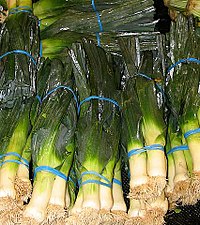The leek , Allium ampeloprasum var. porrum (L.), also sometimes known as Allium porrum, is a vegetable which belongs, along with the onion and garlic, to the Alliaceae family. Two related vegetables, the elephant garlic and kurrat, are also variant subspecies of Allium ampeloprasum, although different in their uses as food.
The edible part of the leek plant is sometimes called a stem, though technically it is a bundle of leaf sheaths.
Rather than forming a tight bulb like the onion, the leek produces a long cylinder of bundled leaf sheaths which are generally blanched by pushing soil around them (trenching). They are often sold as small seedlings in flats which are started off early in greenhouses, to be planted out as weather permits. Once established in the garden, leeks are hardy; many varieties can be left in the ground during the winter to be harvested as needed.
Leeks usually reach maturity in the autumn months, and they have few pest or disease problems. Leeks can be bunched and harvested early when they are about the size of a finger or pencil, or they can be thinned and allowed to grow to a much larger mature size.
The edible portions of the Leek are the white onion base and light green stalk. The onion-like layers form around a core. The tender core may be eaten, but as the leek ages the core becomes woody and better replanted than eaten. Leeks are an essential ingredient of cock-a-leekie, Leek and Potato Soup and vichyssoise. They can also be used raw in salads, doing especially well when they are the prime ingredient.







No comments:
Post a Comment